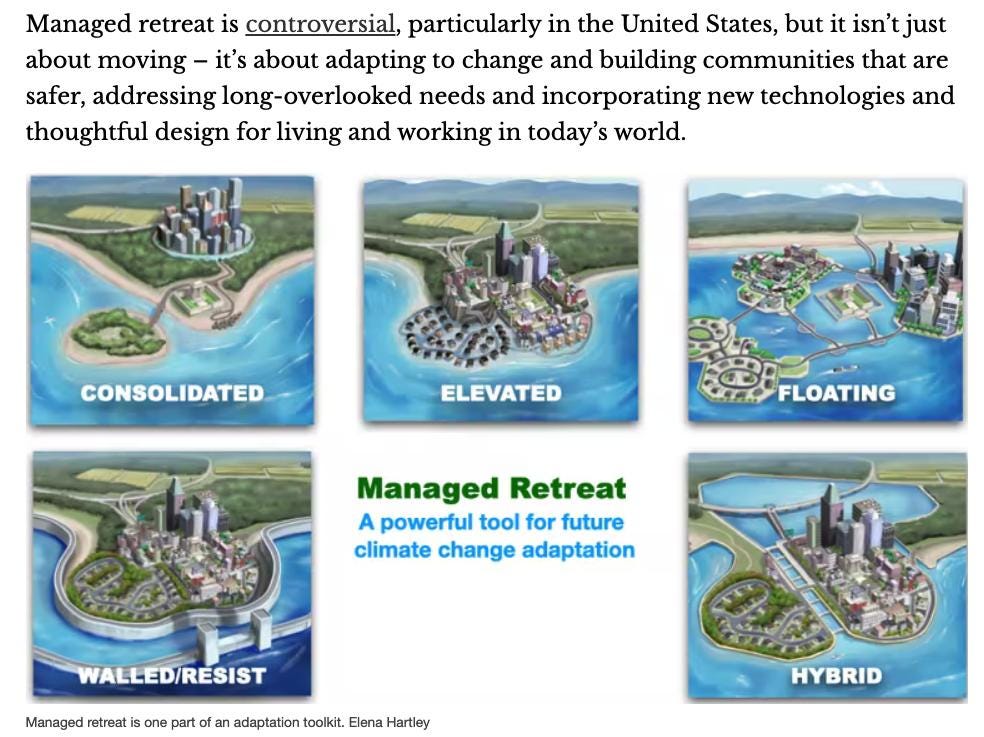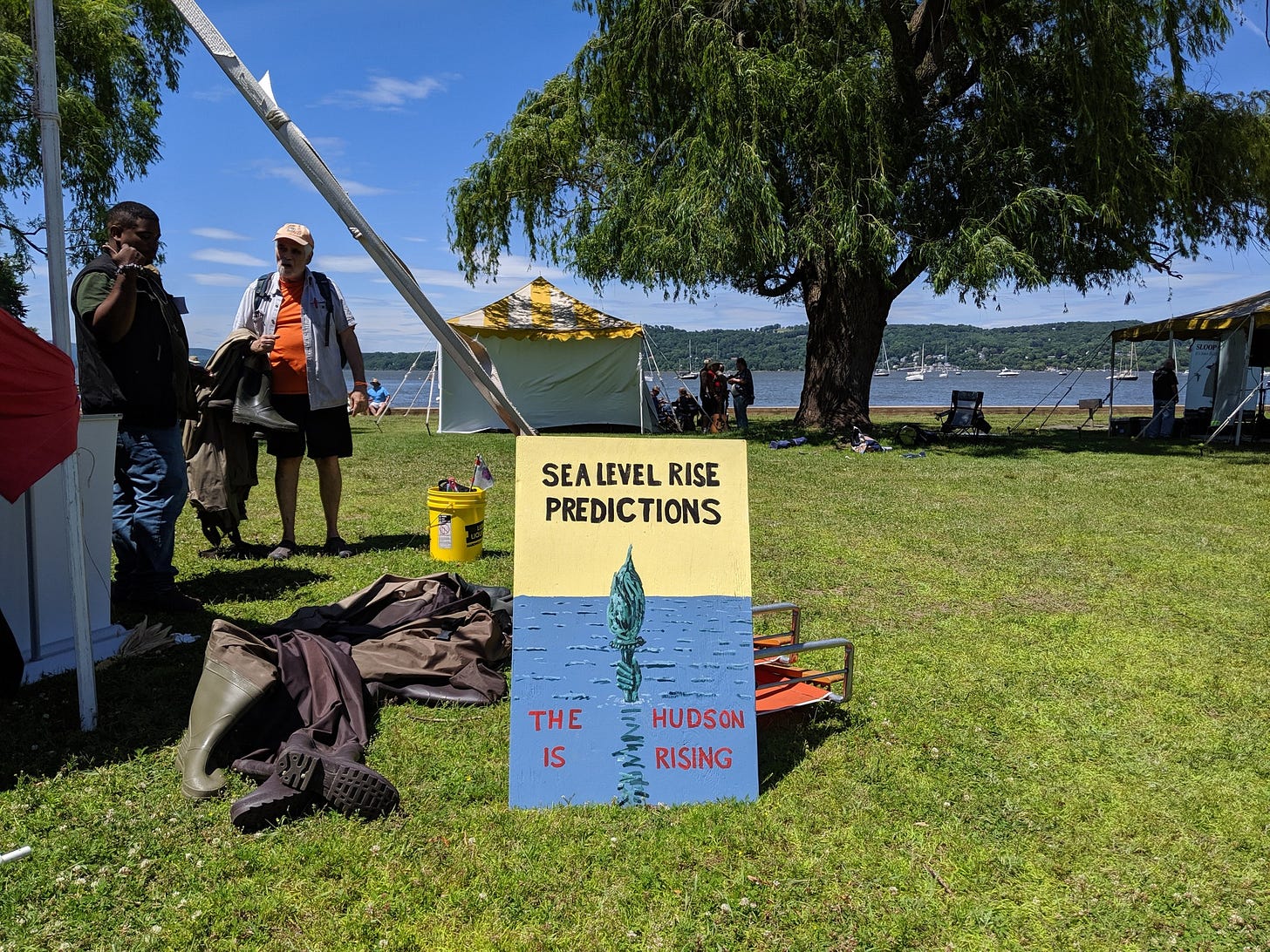A Predicted Foot of Sea Rise by 2050 Spurs Fresh Efforts to Connect Changes in Ice Sheets with Action on Main Street
Please SUBSCRIBE to receive my posts by email.
Watch my related Sustain What webcast on the many meanings of collapse.
Look twice at COLLAPSE headlines
In December, scientists held a news conference warning that the floating ice shelf protruding into the sea in front of Antarctica's "Doomsday" glacier could collapse in a few years. That could spark a cascading collapse of inland ice. The British Antarctic Survey issued a statement warning, "If it does collapse, global sea levels would rise by several feet – putting millions of people living in coastal locations in danger from extreme flooding."
The result was an extreme storm of ominous headlines and doom-laden clicks. Watch my recent Sustain What #Watchword webcast clarifying what Antarctic researchers mean when they say "collapse" - basically processes that take many decades or centuries. Here's a rough transcript. The wonderfully clear statement from Antarctic scientist Bethan Davies in this short excerpt really captures the issue perfectly:
That flurry of coverage also largely missed the reality that the research behind the collapse news was both novel and not yet through peer review, with other research just a few months earlier finding that the jumble of resulting ice at the glacier's disintegrating snout could act as a big long-lasting brake. That's a prime recipe for what I call a media whiplash effect.
Indeed, after that Antarctic splash, the world swung back to tracking the pandemic, Ukraine, inflation, sports.
Not only was much of the resulting media blitz a mangle of overstatement, but it also contained no actionable information for coastal communities.
Act on current climate and coastal clarity
Increasingly, scientists studying both ends of global warming's sea-level challenge - the flows of polar ice and meltwater raising sea levels and the impacts of rising waters a world away - are working to shift the public and policy focus away from scary, but tentative, ice-sheet science and toward the need to deal right now with the well-established realities of near-term sea-level rise.
The National Oceanic and Atmospheric Administration, with a host of government and academic partners, recently issued a new set of sea-level projections for the United States that put firm, tough numbers on the near-term rise that is already locked in.
Much of coastal America, particularly the Gulf states and East Coast, will be grappling with a foot or more of sea-level rise by 2050 - well within the lifetimes of many politicians and within the scope of today's 30-year mortgages.
Put another way, this means many coastal communities face a sea rise in the next 30 years as big as what they experienced over the last 100 years.
More important, that foot will dramatically worsen storm-surge impacts and the frequency of high-tide flooding. The rate of "minor" flooding has doubled since 2000 and looks to double again by 2030, the new report concluded. By 2050, moderate, damaging flooding is expected to occur, on average, more than 10 times as often as it does today, "and can be intensified by local factors," the report said.
Many feet of additional inundation are coming, of course, although those long-term assessments come with enduring and substantial uncertainty - much of it due to the complexities in how fast the world's great ice sheets respond to both ocean and climate warming.
Cut CO₂ for the long haul; cut coastal risk now
While short-term momentum is locked in, the report stresses that global action to curb climate-heating greenhouse gases could still significantly lessen sea-level rise toward and beyond 2100 - potentially greatly constraining how much change future generations of shore dwellers will have to live with, or retreat from.
The new report also offers region by region detail - which is vital given the enormous variability in coastal futures around this country, with some areas facing much greater, or smaller, rates of change depending on a host of local factors including rapid subsidence of some coastal lands and variations in dynamics in different ocean basins.
But what do communities do with this mix of near-term clarity and long-term murkiness?
I hosted an illuminating Sustain What webcast on this theme featuring two leading researchers working at the far ends of the challenge - on faraway Antarctic ice sheets and flood-prone coastal streets - and the conversation identified some under-appreciated and urgent needs.
Particularly important, the chat illuminated a vital role for academia, with hundreds of universities capable of fostering connectivity between expertise and needs - IF they foster campus connectivity among the many disciplines that need to be engaged.
Here's the recording: "Can a New Forecast of Accelerated Sea-Level Rise Spur Coastal Resilience?" You can also watch and share our discussion on Facebook, LinkedIn and Twitter.
My guests were A.R. Siders, a core faculty member at the Disaster Research Center of the University of Delaware who focuses on climate change adaptation governance and related social justice issues; and Jeremy Bassis, a University of Michigan glaciologist focused both on the dynamics of Antarctic ice loss and boosting the societal benefits of such research. He's the lead author on that 2021 modeling study I referenced above that showed the "Doomsday" Thwaites glacier could have a much slower meltdown than what's been in headlines.
I had organized the session initially around a commentary Bassis wrote in the American Geophysical Union journal Eos titled "Quit Worrying About Uncertainty in Sea Level Projections." His key point, echoing the NOAA report, was to get busy responding to what is already well understood. Don't wait for clarity on the long-term risk.
“Managed retreat” - lousy name, essential practice
We also explored an invaluable paper in the journal Science and related commentary in The Conversation by A.R. Siders and Katharine Mach, an associate professor in environmental policy at the University of Miami, who press the case for communities to become comfortable with shaping policies around the reality of having no new "normal" coastline - a strategy they and others call "managed retreat." As they write, "'Managed retreat’ done right can reinvent cities so they’re better for everyone – and avoid harm from flooding, heat and fires." Here's an illustration from the commentary:
Finally, we touched on a great 2018 paper laying out what's needed to translate science illuminating coastal change into societal response: "From ice sheets to main streets: Intermediaries connect climate scientists to coastal adaptation."
The lead author was Lizz Ultree, a former student of Bassis's who is now an assistant professor at Middlebury College. Her paper illuminates a glaring need and opportunity that has come up in a heap of my Sustain What webcasts on vulnerability reduction facing climate hazards - the importance of trained individuals and organizations that serve as intermediaries, translators and facilitators.
As I read her paper I saw lots of resonance with the Thriving Earth Exchange project of the American Geophysical Union, essentially a Match.com for Earth science expertise and communities at risk. I'll be writing more on this soon. Here's a video intro.
You can explore a rough transcript of my conversation with Siders and Bassis here if you don't want to sit through the video. I'll post some of my favorite moments here when I have more time.
But there's a lot going on on the planet right now, and I'm going to focus next on natural gas and the Ukraine conflict.
Resources
Here's a recording of the NOAA report release including great questions from a batch of climate-focused reporters:
Your turn
What resources do you utilize, or lack, as you try to build a more resilient community? Please weigh in in the comments and I'll build a future post around your experiences.
As an example, in the metropolitan area around New York, the Regional Plan Association has published several maps showing the areas and infrastructure that will be inundated by six and 12 inches of sea level rise in coastal communities. They're developing scalable flood buyout programs and regional approaches to adaptation planning.
Help build Sustain What
Send me feedback (including corrections!), tips, ideas here.
Find my social media accounts, books and music in a click here. And please share Sustain What with solution-focused friends and colleagues!
Parting shot
The Beacon Sloop Club, an organization founded by my friend Pete Seeger and many other Hudson Valley neighbors, holds an annual strawberry festival on what used to be a landfill jutting into the river in Beacon, N.Y. I shot this photo there.










